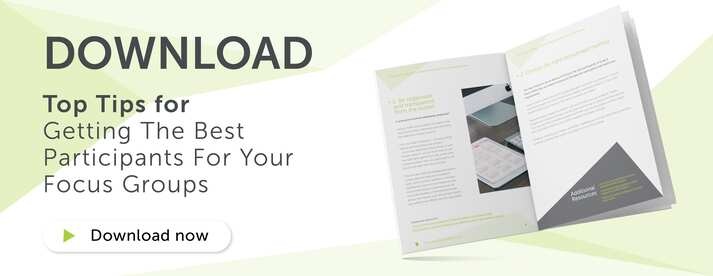
5 Things to Think About When Conducting Research with Customer Lists
Looking for more advanced tips? Check out our latest guide to customer list recruitment here.
When it comes to successful consumer market research recruitment, it all comes down to the participants you recruit. If you want to achieve high-quality results, then you need to recruit high-quality respondents who fulfil the necessary criteria. And in order to find them, you might very well be asked to use list recruitment.
How to Conduct Research With Customer Lists
List recruitment is exactly what it sounds like - it’s when you have a specific list of data to recruit from. It’s a particularly popular consumer market research recruitment method with retailers who want to research people who shop with certain brands, or for financial companies who have a specific list of customers they want to recruit from.

Despite its on-the-surface simplicity however, there are some important things to consider if you have been asked to conduct consumer market research using a customer list! Here are some of the top things we’d recommend you add to the list:
Co-brand if you can
When conducting consumer market research with customer lists, co-branding with the client's logo and branding is really important for a number of reasons. For starters, if the client is happy for you to co-brand, it really helps to win people’s trust. By having - and sharing - as much information as possible from the client such as the research details and a client point of contact from the beginning, it makes everything more open and honest. This will help make your participants more comfortable when the project kicks off, because they’ll know exactly what is expected of them and why. Co-branding can also be a big help in list recruitment when it comes to consent and GDPR, because you can link to the clients’ privacy policy on their website to make sure everyone is completely clear and gives informed consent. Not only that, but it also helps to make the project sound more appealing and exciting too - especially if the research is for a big brand!
In fact, we recently underwent some consumer market research recruitment for a study with a well-known retail brand who initially didn’t want to reveal their name. This resulted in a low incidence of applications - but once we co-branded and added the client logo, we saw a huge increase in applications!
It’s all about quality
Another important thing to consider with list recruitment is to make sure the data is as up to date as possible. The quality and relevance of the data can have a huge impact on how smoothly the recruit goes, which can then have a knock-on effect on the feasibility and timing of your research.
For example, if you are working with a client who wants to conduct research with respondents of a certain age (for example, students), but the data is a few years out of date, then information on your list isn’t going to be correct. Or it might be that you have a list of initials and email addresses rather than full names, email addresses and phone numbers.
When it comes to list recruitment, the devil is in the detail - and the more detail you’ve got, the easier your job will be. It’s really important that the client knows what they want from their list and that all the information you need is on there so you can accurately target the best people for the research. Otherwise, you’ve just got a list of people who aren't at all relevant for your research!
Three strikes and you’re out
Just because you are contacting people off a list, it doesn’t mean that you shouldn’t be careful that you don’t hassle people to take part. We recommend following the golden rule of three attempts to contact people on the list before stopping - any more and they could start to get annoyed!
Start by sending an email: this way, you can include as much information as possible about the study to get people excited about taking part. Email is also a nice and gentle approach, and a lot of people prefer to be contacted this way.
Calling or texting people is another option that works really well - just remember that it can be much harder to contact people this way, as they can often think it’s a sales call and hang up before you have a chance to properly explain why you are calling! Before you start reaching out to people on the list, it’s also really important to get confirmation from the client that everyone has agreed to be contacted by a third party. It’s not uncommon for people to question why you are calling and where you got their details from. This can make them unsure about whether they want to take part in the study. However, if you can reassure your respondents where you got their details from and what they have agreed to previously, they will be more open to taking part.

Give as much info as possible
When conducting market research with customer lists, remember that your audience might not be as savvy with market research as those from a panel. They tend to need hand-holding more because it will be you that approaches them rather than vice versa - which means they won’t be as clued up on market research and how it works.
With this in mind, it’s really important to make sure that your potential participants are as comfortable as possible. From information on the privacy policy to what they should expect in the research and why, by arming yourself with as much information as possible, you can be completely transparent and arm your participants with all the info on the project they could possibly need. The more comfortable your participants are, the better your results will be - so make sure you put them at ease and answer any questions they might have.
Make sure you over-recruit
Although participants sourced from a list are usually high-quality respondents that meet specific criteria, they can also be less reliable than those recruited via other consumer market research recruitment methods. This could be because they haven’t voluntarily signed up to take part in research by themselves (so they aren’t as motivated to take part), or because you don’t have such a strong relationship with them. As a result, they may be more likely to drop out of the research at the last minute or even not show up on the day.
We’d therefore always strongly recommend factoring in an over-recruit. That way, if anything does go wrong and people do drop out, you’ll have high-quality respondents who are ready to go and willing to step in and take their place.
A lot of people think that an over recruit is an additional expense. But trust us - it could save you a considerable amount of money in the long run! And it’s definitely worth the peace of mind from knowing you have all eventualities covered whatever happens on the day.
If you’re working with specific criteria, customer lists as a form of consumer market research recruitment can be a fantastic way to target high-quality participants. Just make sure you thoroughly plan your approach and that you carefully consider all the points above!
If you’d like to find out more about how to source the best possible participants for your next qual MR study, make sure you download our guide.














